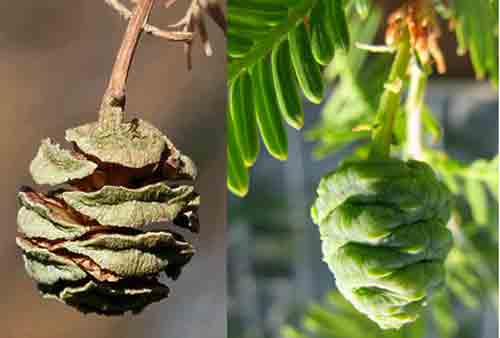Pine Cone Strobile Fossil Giant Sequoia mm 20 x 17 x 14 gr 4.3 Metasequoia occidentalis Conifers Plants Trees Fossilized Vegetables Extinct Gymnosperms Mesozoic Cretaceous Collecting Paleontology Botany Museum.
Nice fossilized find of a fossilized Pine Cone of Cupressaceae Conifers from the Upper Cretaceous of North America from the Hell Creek Formation, a representative good quality collectible sample well preserved, with clear details of the structure of the globose cone with triangular scales arranged in a decussate manner.
Only a piece, as in photos.
The Pine Cone, also called Cone or Strobile, is the pseudo Fruit of Conifers.
Typical formation consisting of an axis on which the fertile leaves carrying the pollen sacs (
male cones) or the ovules (
female cones) are spirally inserted. Generally, female strobili become
woody after fertilization.
Metasequoia occidentalis is an extinct species of Giant Sequoia, an evergreen Conifer of the Cupressaceae family that is found in a fossil state throughout the northern hemisphere.
It is one of three extinct species of Metasequoia ((
M. foxii, M. milleri, M. occidentalis) that are currently recognized as valid.
Fossil remains of Metasequoia had been found in Europe and North America as early as the 1800s, but had been assigned to a variety of other genera such as
Sequoia (redwoods) and
Taxodium (peeled cypresses). Metasequoia was first described as a fossil from the
Mesozoic Era in 1941. In 1951 the misclassified species was reassigned as M. Occidentalis based on their close resemblance to the living
Metasequoia glyptostroboides, a tree up to 40 meters tall.

Like the living Metasequoia, M. Occidentalis was
deciduous. The foliage consists of twigs with oppositely arranged leaves. The
leaves are linear oval in shape. The
cones are globose or ovoid, with triangular scales arranged in a decussate manner and are carried on long leafless stems.
Large petrified
trunks and stumps of the extinct Metasequoia Occidentalis are well known from Cretaceous to Miocene strata, but no more fossils are known after this. The taxon was therefore considered to have become extinct during the Miocene.
This sequoia was therefore known to scholars only for the fossil remains found, but in the mid-1940s a group of botanists ventured into remote areas of the Chinese provinces of Sichuan and Hubei, where around 100 large specimens of Metasequoia glyptostroboides were found, escaped the attention of 19th century Western botanists. It was then deduced that Metasequoia has experienced morphological stasis for the past 65 million years, which would explain why modern Metasequoia glyptostroboides appears identical to its Cretaceous period ancestors.
The
seeds of the living Metasequoia were then collected and distributed to North American and European botanists, also reaching Italy, where the first specimens were germinated. Since the tree is recently introduced and
few adult specimens exist, the potential properties of the wood are not yet known.
Based on DNA analyses, the Metasequoia genus is considered very similar to the American sequoias (Sequoia sempervirens and Sequoiadendron giganteum).



